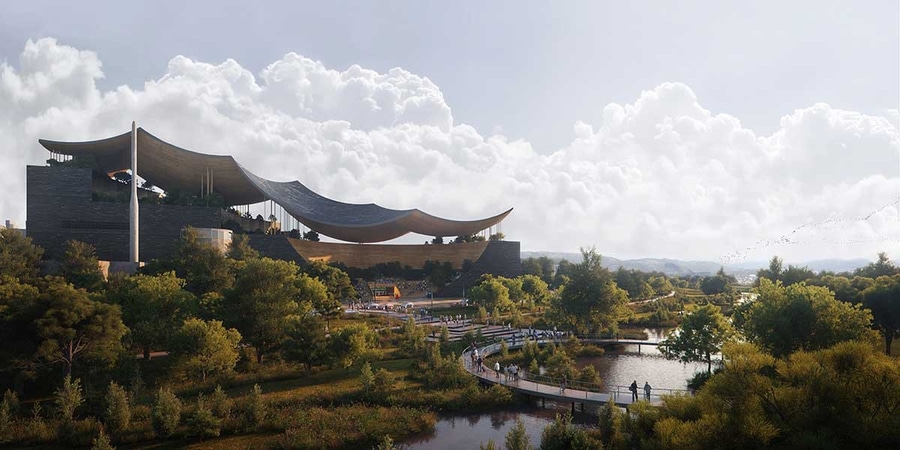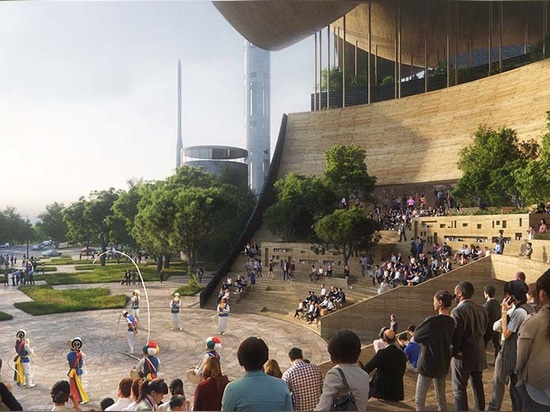
#PUBLIC ARCHITECTURE PROJECTS
Croquis Design Studio Unveils Its Competition Proposal For City Main Library In Gwangju, South Korea
Dubai-based architecture studio Croquis Design Studio has unveiled its competition proposal for the new City Main library Gwangju, Gwangju, South Korea.
Dubbed City Main library Gwangju, the design addresses to all aspects of the preservation and dissemination of the vast array of human thought and imagination with its wavy roof.
Described with terms; "Once Upon A Forest" and "Beyond books", the architects try to achieve the value of the library in the modern society, with bearing questions like: How should books and written information in this age exist together with digitized information?
The office asks: What will be the trend in the future and what would be our spatial response to this? A Place of social and urban solidarity, A Place of information and knowledge, A place of people and books, New cityscape that encompasses past and future.
For thousands of years’ libraries have acted as repositories of knowledge, as places for quiet reflection and learning, but also as forums for debate and discussion.
From the Great Library of ancient Alexandria, to the British Library, to the US Library of Congress, and France’s Bibliotheque Nationale, to Ireland’s Trinity College, which is home to more than five million books, the written word has captivated the mind for millennia.
And now, unique to the world of wisdom, comes Once Upon a Forest – a fusion of human thought and ingenuity, which co-exists and complements the natural world with its open green spaces, trees, plants and watercourses an integral part of the overall experience for the visitor.
Located in the Korean city of Gwangju, long renown as a place of culture and educational excellence, the project combines all aspects of creativity, whether written, spoken, performed or preserved in digital formats. It recognizes - and celebrates - the fact that to prosper and remain relevant in the age of digitalization, libraries have to fully embrace both the physical and the virtual.
The written word will never die, as the human race will always need to record its achievements, thoughts and emotions - and have a realm allowing imagination to run free and reach out to hearts and minds across the globe.
But the way information is accessed has changed dramatically in recent years, and libraries can point the pathway to tomorrow, allowing access to cyberspace and acting as forums for debate and discourse, theatres for the expression of new ideas, and spaces to promote interaction.
Once Upon A Forest goes beyond books – it looks towards all aspects of the preservation and dissemination of the vast array of human thought and imagination.
It is a space for learning, and interaction for both young and old, a cross-cultural centre which welcomes all, and allows enquiring minds to reach out into new areas, explore philosophies, and research the world and beyond in all its myriad facets - while at the same time acting as a forum for connectivity, with speakers, debates, performances and artistic showcases.
It is a home for traditional literary forms - books, newspapers, journals, magazines, scientific papers, discourses and other forms of text. But it also encompasses the ever-growing field of the virtual, with access to all that exists in cyberspace.
Once upon a Forest makes an immediate statement to those approaching, as its draws them into its spell. Its black wooden exterior, a striking solid form with sloping roofs reflecting a traditional Korean design vernacular, captivates the immediate skyline.
And as the eye is drawn upward, circular roofing forms envelope an outdoor amphiteatre – evocative of the cloud within which so much of today’s digital data is stored. So visitors envisage the realm of knowledge of the virtual world which encompasses and surrounds them – and which is embodied in the structure beneath.
All things are possible in Once Upon a Forest – access to the ever-expanding thoughts, philosophies, imagination and history of the past, present and future, in whatever format they are stored or recorded.
Menwhile the interior is constructed of golden coloured wood – a stark contrast to the exterior but one which complements it in visual terms and beckons in the visitor. Together they resemble the form of an open book, ready to offer up its knowledge.
The library has woodland at its heart, trees are a major part of its rooftops, the sides of its amphitheatre and its open spaces - which are as important as the collections of literature, images, virtual data, music, news and culture which provide its essence.
A media wall allows for projected images of all kinds, from lectures, debates and performances, to reflections of the natural world, or abstract viewings. Once Upon a Forest acts as a focus for the urban environment of Gwangju, a statement of location, a place of cultural exchange and a venue for human interconnectivity.
A series of pathways entice the visitor in, leading from the urban environment, across water and through woodland, in order to allow those looking for the experience of knowledge to enter a state of reception for the mind – away from the everyday and open to the new. The project is a major design statement, standing out among its surroundings, but once inside also playful and welcoming.
On arrival the gaze is drawn upwards, seducing the viewer into entering the building to explore its treasures.
And after the landscaping draws seekers of experience in, an entrance moment awaits. A spiral design allows views through all three stories - up and out to the yonder, blue skies, clouds or a star-filled horizon, depending on the time of day or season of the year.
Outside is the infinity of the universe – inside is the infinite potential of the human mind.
No views of the building, whether from the amphitheater or the interior are the same. Each visit provides a new and different range of thoughts and emotions. These can include quietly reading in the main hall while a performance takes place outside – a combination of inner thought and outward experience - or a climb to the apex of the building.
There on view is the surrounding contrast of the urban and the natural, while a visitor can gaze down to ground level via the series of carefully arranged apertures, which also bring natural light deep into the structure.
All are welcome to Once Upon a Forest – the lone seeker of knowledge, friends and families seeking for a convivial place for social interaction, or close partners looking for a place they can call their own.
All can find their own space, amidst interior seating surrounded by the shelves of books or on the stepped exterior of the amphitheater.
While outside of the main collection of written material, this space has its own bookshelves, forming a community library for those who want to disseminate the written words they cherish. Visitors can simply pick up a book and sit down and read it, or take it away with them. It is where others have deposited a work they would like their fellow readers to experience – a free and easy way for a community to share its appreciation of literature.
To complement the experience of a visit, this holistic, natural environment - which celebrates the written word - is located next to what at first appears to be a distinct contrast. A former mechanised and industrial plant which used to be a commercial incinerator.
But rather than seek to dominate, by demolition or radical exterior overhall, Once Upon a Forest choses to assimilate.
The older building – connected by a bridge to the library – is white in colour and made of steel, providing a sharp contrast to its black wooden form.
But this juxtaposition of the old and the new also demonstrates how shapes have a continuity – emphasised by the curving roofs of both. Inside the industrial space could be performance arenas, conference halls, study areas, or places for the display of artifacts. All are aspects which complement and enhance the main library – and demonstrate that no space is redundant and that preservation and new usage can be applied to any structure.
Bringing contemporary design, traditional elements,and combining existing urbanism and new creativity, the library makes for a focal point for the interaction of the mind and the connectivity of humanity.
The natural world, water, trees and grass - the world of wisdom, books and digital data - the expression of ideas, spoken or performed - and the human experience, solitary or collectively, come together in Once Upon a Forest.




